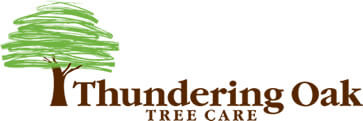Winter Tree Care
In winter, when most trees and shrubs are dormant in Pierce and South King County, there are plenty of things for you or your tree care experts at Thundering Oak to do to prepare your trees for a healthy start in the spring.
- Add Mulch
- Avoid Diseases
- Plant New Trees and Shrubs
- Prune Your Trees and Shrubs
- Tree Safety: Reduce Hazards to Avoid Injury or Damage
Add Mulch
A thin layer (about 2 inches) of composted organic mulch around trees and shrubs will help moderate soil moisture and temperature. It will also help the surface soil heat up a little faster in the spring for that first early new growth.
Avoid Disease
A final raking and clean-up under and around trees and shrubs are two of the best natural ways to help reduce leaf fungal pathogens. Most fungal spores hang out on or under the fallen leaves, waiting for late winter rains and warmer weather to start popping into the air to re-infect the new leaf buds. Stone fruits (cherry trees, plum trees, peach trees, and apricot trees), flowering cherry trees (weeping, kwanzan, autumnalis) as well as apple trees and pear trees are particularly susceptible to leaf spot, brown rot, and apple scab. This simple final clean-up before the end of January can really help reduce future outbreak levels in your trees and shrubs. Time invested in winter will pay big dividends in the spring and summer. Your trees will look beautiful, and you’ll avoid the time and expense of helping your trees and shrubs overcome leaf fungal pathogens.
Planting
Most nurseries receive lots of new trees and shrubs in early January. As long as the ground isn’t frozen, winter is an excellent time for planting. Remember, the plants in your garden look farther apart without foliage, so be extra aware of spacing and give them all plenty of room to grow to their natural size. Read our blog post on How to Plant a Tree or call us to plant your trees to get them off to a healthy start.
Pruning
Winter is a great time to prune most trees and large shrubs. You’ll find it is easier to see the branch and trunk structure with the leaves gone. Only remove dead branches and those that are placed poorly within the canopy. Fruit and flowering trees are perhaps the best candidates for winter pruning – it is easier to distinguish between fruit and vegetative sprouts, for instance – and the fruit buds have not set yet.
Tree Safety
Winter is an excellent time to have your large deciduous trees inspected by a certified arborist. Broken or dead tree limbs, split tops, decay columns, fungal fruiting bodies, and more are easier to see when the leaves are gone. The safety of people and property around your trees is your responsibility, so it’s essential to know if your trees are healthy or have signs of disease.
Act promptly to remedy tree hazards before they cause injury or property damage. Knowing your trees are healthy provides welcome peace of mind during our wild winter ice and wind storms in Pierce and South King County.
Your arborists and team of tree care specialists at Thundering Oak have the expertise and experience to help with all of your tree and landscape care needs.
Contact us today at 253-288-8733 to schedule tree care services.
“Aggressive thinning can make the remaining branches more vulnerable to failure…”
